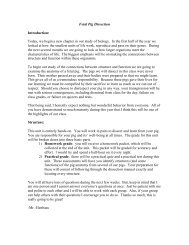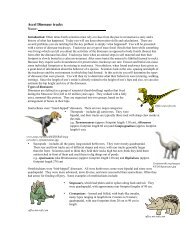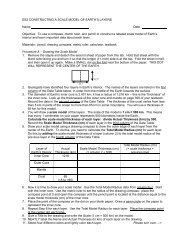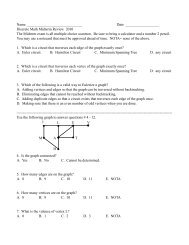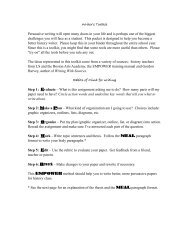ES1 Elliptical Orbits Earth in Space Lab # 2
ES1 Elliptical Orbits Earth in Space Lab # 2
ES1 Elliptical Orbits Earth in Space Lab # 2
You also want an ePaper? Increase the reach of your titles
YUMPU automatically turns print PDFs into web optimized ePapers that Google loves.
Names _____________________&______________________Block ___Date__________! yours (first and last names) partner’s<strong>ES1</strong> <strong>Elliptical</strong> <strong>Orbits</strong> <strong>Earth</strong> <strong>in</strong> <strong>Space</strong> <strong>Lab</strong> # 2Check class website versions for h<strong>in</strong>ts & changes <strong>in</strong> redyay, bonus pt. because___________oops, no HO, book, head<strong>in</strong>g this date__________=MP(As long as you complete the data table, you can f<strong>in</strong>ish analysis and conclusion at home tonight. Turn <strong>in</strong> ellipses with your names.State the problem To draw an ellipse, calculate its eccentricity, and predict the shape of the earth’s orbit.Background Information! The shape of some oval school tracks are ellipses. The shape of the orbit of each planet <strong>in</strong> our solarsystem is also an ellipse. Unlike a circle, which is a curved shape drawn around a s<strong>in</strong>gle po<strong>in</strong>t, an ellipse isa curved shape that is drawn around two po<strong>in</strong>ts. Each of the po<strong>in</strong>ts is called a focus; together they arecalled the foci of the ellipse. An ellipse is described as eccentric because it is not circular. The more unlikea circle an ellipse becomes, the more eccentric it is. See Figure 1.Materials pencil, 2 thumbtacks, about 15 cm of str<strong>in</strong>g tied <strong>in</strong> a circle,foam core or cardboard piece, metric ruler.Procedure--preview the steps before do<strong>in</strong>g and make a hypothesisat the bottom of this page before you draw the ellipses.Figure 11. If needed, tie the str<strong>in</strong>g ends <strong>in</strong>to a loop about 5 - 6 cm across.2. F<strong>in</strong>d the “Ellipse <strong>Lab</strong> Draw<strong>in</strong>gs” sheet on pg. 4 of the lab. Onepartner removes the last page from their lab to use this and should getan extra copy of the pg. 3 questions. You only need one set of ellipsesfor you and your partner. Measure and mark two dots 1 cm apart <strong>in</strong> thecenter of the top third, mark two more 2.5 cm apart <strong>in</strong> the middle third,and <strong>in</strong> the bottom third, make two dots 4 cm. apart. The str<strong>in</strong>g will betight for 4 cm. See Figure 2. How many millimeters <strong>in</strong> 1 cm?_____3. Put the paper over the cardboard, and push the thumbtacks <strong>in</strong>to one setof po<strong>in</strong>ts, far enough to be firm, but not flat aga<strong>in</strong>st the paper. These are theellipses foci. Put the str<strong>in</strong>g around the thumbtacks, and use the pencil <strong>in</strong>sideit like a draw<strong>in</strong>g pencil to draw an ellipse around the foci, pull<strong>in</strong>g thestr<strong>in</strong>g tight aga<strong>in</strong>st the tacks. See Figure 4. Have one partner hold the tackssteady if needed.4. Repeat step 3 for the other 2 sets of foci. It’s OK if an ellipsegoes off the paper, as long as the major axis (across the tacks) is onthe paper. Obviously, don’t draw on the desk :).5. You can calculate the eccentricity or “out-of-roundness” us<strong>in</strong>gthis equation: (a) distance between foci! ! See Figure 4.! !! ! (b) length of the major axisFigure 2Figure 4Figure 3Hypothesis: Which ellipse do you th<strong>in</strong>k will be most eccentric, and why?__________________________pg. 1 of 3 ES 1 Sanders-Flem<strong>in</strong>g Ellipses <strong>Lab</strong> from Prentice-Hall <strong>Lab</strong> Manual 10/21/13 4:32 AM
Look back at Figure 4 to identify the foci and major axis. Measure the distance between the thumbtacks foreach ellipse <strong>in</strong> millimeters (a <strong>in</strong> table below). Put the data <strong>in</strong> the table.!! Draw a l<strong>in</strong>e across the foci to the edges of the ellipse to see the major axis. Measure it <strong>in</strong> mm also.! Repeat for all 3 ellipses and calculate the eccentricity, convert<strong>in</strong>g it to a decimal with 2 digit accuracy.Why do you round it? (Consult Density and Measurement notes if needed.)__________________________Compare the roundness of the 3 ellipses--they may look circular, but they’re not! (Compare major axis to“m<strong>in</strong>or axis”--perpendicular to focii, if you want to prove it to yourself. Which should be shorter?_________)Ellipsetable-10 pts.(a) Distance betweenfoci (mm). give unitfor all. Known--seeyour draw<strong>in</strong>gs(b) Length ofmajor axis(mm)Eccentricity: a/bConvert to decimal (2 digit accuracy -- why?Show work.Look at ellipses.Which isroundest? leastround?123The eccentricity should be between 0 and 1, with no unit. Why does a ratio like this have no unit?______________________________________________________________________________________(H<strong>in</strong>t: Th<strong>in</strong>k about what you are compar<strong>in</strong>g: what unit is on the top and bottom of this fraction?________)Analysis1. How does the shape (not the size) of the ellipse change when the loop is the same size, and the foci arespread apart?2. Look at the eccentricities of your ellipse. As the ellipse becomes rounder, does the eccentricity get higheror lower?______________What would the eccentricity be of a circle_________ (h<strong>in</strong>t--what is the distance between foci?________)What would the eccentricity be of a l<strong>in</strong>e_________ (h<strong>in</strong>t--how does the distance between foci compare tothe length of the major axis?____________________________________________________________emptysunLook at your Newton’s Kepler’s notes and expla<strong>in</strong> why0
PlanetMercury 0.21Venus 0.01Mars 0.09Jupiter 0.05Saturn 0.06EccentricityMeasure the focal distance and majoraxis on the ellipse on p. 2 and fill<strong>in</strong> the table at right. Don’t yet calculatethe eccentricity. Based on yourdata, what do you estimate the eccentricitymight be?_______NOW calculate the eccentricity us<strong>in</strong>gthe data table and show your work. IsDo!the earth’s orbit a perfect circle?______ How do you know?Uranus 0.05Neptune 0.01Pluto 0.25Figure 5Which diagram <strong>in</strong> Figure 5. above most accurately shows the shape of the earth’s orbit drawn toscale?______ Look back at pg. 2 to compare them.2. Compare the orbits of the planets and Pluto to the earth’s from the table above. On pg. 2, you calculatedthe earth’s orbit to be:_______ (This should be close to the actual measurement 0.02, if not, try aga<strong>in</strong>).Which solar system bodies are more eccentric than earth’s?Which planets’ orbits are most nearly round?3. What is one reason Pluto is no longer considered a planet which is emphasized <strong>in</strong> this lab?Give a question or new concept you got from this lab:Hand <strong>in</strong> your ellipse lab draw<strong>in</strong>gs stapled to either yours or your partner’s lab. If your ellipses are stapled toour partner’s lab, say so!Grade Notes for student # wrong/34@3______ grade = ______complete, fix & expla<strong>in</strong> _______notes only = 25%, Incompleteor too many <strong>in</strong>correct: 50% = miss<strong>in</strong>g. late = -50% may use pass. not <strong>in</strong> before discussion? show ahead andcorrect <strong>in</strong> new color. May come get corrections.(MCGC) F<strong>in</strong>ished >1 week after absence or lab <strong>in</strong> class: = -25%pg. 3 of 3 ES 1 Sanders-Flem<strong>in</strong>g Ellipses <strong>Lab</strong> from Prentice-Hall <strong>Lab</strong> Manual 10/21/13 4:32 AM


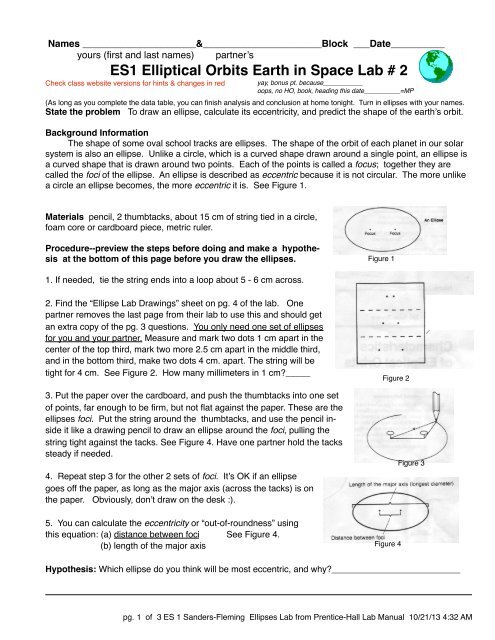


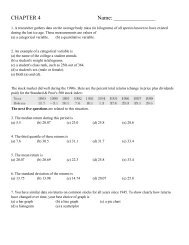


![';1asAu ro; las I sgeo8 leuo!]eslanuol aql utelqo o1 palenttouJ ue I ...](https://img.yumpu.com/49072782/1/190x221/1asau-ro-las-i-sgeo8-leuoeslanuol-aql-utelqo-o1-palenttouj-ue-i-.jpg?quality=85)

